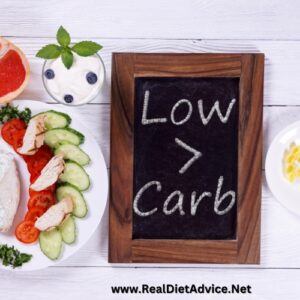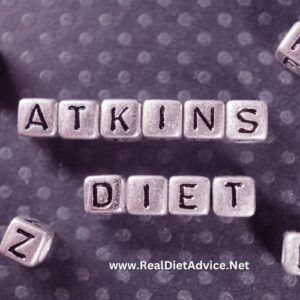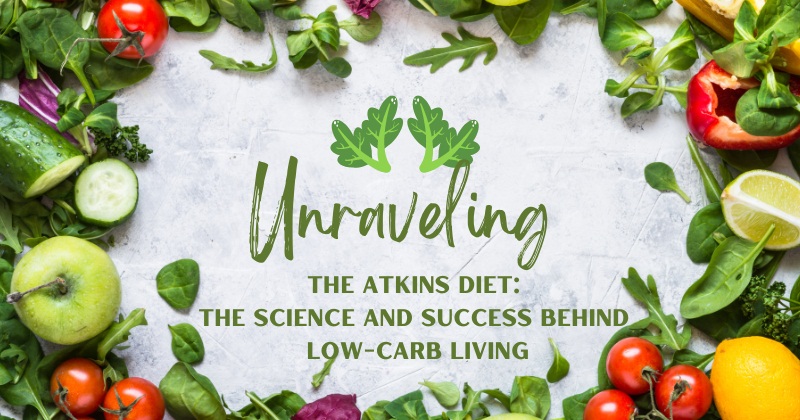Unraveling the atkins diet, is one of those interesting diets that we will examine below. But, before we proceed allow me to give you a short introduction.
People often go on diets. Many people are now focusing on the need to lose some weight due to unhealthy eating and lack of physical activity that have permeated our society. Many people are becoming overweight or obese.
The Atkins diet was created by Robert Atkins who was a physician and cardiologist. He died in 2003.
Atkins developed the Atkins diet as a result of his own bad eating habits and weight increase. He began a strict diet, which eliminated sugar and starches and increased fats and proteins. It was a great success and led him to create the Atkins Diet.
Many people have seen weight loss with this diet, but critics continue to be concerned about the high fat and protein content.
What is the Atkins Diet? The Atkins diet is a low carbohydrate eating program that has proven to help with weight loss. It does this by converting fat stores into fuel, which then burns off body fat. The diet is unique because it allows foods like bacon, which are normally associated with weight gain. Some of the foods that you can eat at first are restricted. As you progress on the diet, new food options can be added.

1. What is allowed and not allowed on the Atkins Diet’s Beginnings?
The diet starts with a maximum of 20 grams of carbohydrate per day. Most of these carbohydrates come from vegetables. Protein comes from red meat, poultry, fish, eggs and butter.
Bread, pasta, fruits, nuts, seeds and caffeine are some of the foods that people on the Atkins Diet should avoid at first.
After a person progresses with the diet, more carbohydrates and fruit can be added. After the diet is completed, a person can return to their normal diet by using the tips that they learned.
Each phase of the Atkins diet has its own guidelines. The Atkins diet is structured into four phases, each with its own set of guidelines. It’s important to monitor your body’s reaction during this phase. Some people may be able to tolerate more carbs, while others will need to limit their intake to maintain weight loss.
It’s also important to keep in mind that the Atkins Diet isn’t only about weight loss, but about adopting healthy eating habits over the long term. Continue to apply the principles that you learned after completing the Atkins diet. For example, prioritizing complex carbohydrates, lean proteins and healthy fats while limiting sugars and processed foods. The Atkins diet will serve as a step towards a balanced, sustainable diet that promotes your long-term health and wellbeing.
2. What are the advantages of Atkins Diets?
Atkins does not require you to purchase and have meals delivered to your house. Also, there are no mandatory weekly meetings.
The Atkins diet’s flexibility and convenience are two of its biggest advantages. It is easy to incorporate into different lifestyles, as it does not require the purchase of specialized meals or regular meetings. This diet is based on foods you can buy at any supermarket. It’s easy to follow and relatively inexpensive.
The diet is structured, and it guides people through a gradual dietary change. It is especially beneficial to those who have difficulty making sudden and drastic changes in their eating habits. Starting with a low carb phase and slowly reintroducing carbohydrates, people can better understand how their body responds to different foods.
Atkins also promotes weight loss, better blood sugar control and other health benefits. High in protein, it can help promote satiety, support muscle maintenance and encourage the consumption of unprocessed, nutrient dense foods. As with any diet, you should consult a healthcare professional or dietitian before deciding if it is right for your health goals and needs.

3. What Are the Disadvantages to an Atkins Diet Diet?
This diet releases ketones, which are produced when fat is burned for energy. You may experience headaches and a bad smell in your mouth as a result.
You may also not get all the nutrition you need if you cut out many food groups at the start of your diet.
The diet’s reliance on animal protein, such as red meat, for weight loss has been criticized. Many studies suggest that consuming large quantities of red meat can be harmful to your health.
On the basis of this criticism, however, newer versions have focused on getting more protein from healthier sources such as lentils and olive oil.
Atkins is not recommended for people with certain medical conditions. If you suffer from diabetes, high cholesterol or high blood pressure, you should avoid high-protein diets such as Atkins.
The Atkins diet can also be difficult to maintain over the long-term. It is possible to feel deprivation and frustration during the initial phase of this diet. It can be difficult for some people to adhere to the diet in social situations, where carbohydrate-rich foods are common.
If not managed properly, the Atkins Diet can also lead to nutritional deficiencies. You may miss out on important vitamins, minerals and fiber if you restrict certain food groups. This can have a negative impact on your health.
Moreover, the high concentration of protein and fats in this diet, especially those from animal sources, may not be suitable to everyone. People with kidney disease should avoid eating high-protein diets. While the newer versions encourage healthier sources of protein, they may not be suitable for vegetarians and vegans.
The Atkins diet also requires self-monitoring, and self-discipline. Some people may find it difficult to stick to a diet plan without the accountability provided by group meetings. Before starting the Atkins Diet, it’s best to speak with a doctor or dietitian about the risks and benefits.
4. Do you need to exercise?
The Atkins diet, like most others, recommends 30 minutes of daily exercise. Exercise can be as simple as taking a walk for 30 minutes.
Exercise is an important part of a healthy lifestyle, and that includes the Atkins diet. Regular physical activity is not only beneficial for weight loss, but it also has numerous other health benefits. These include improved cardiovascular health, higher energy levels, a better mood and improved sleep quality. Exercise also helps maintain muscle mass which is important for weight loss, as it prevents your metabolism from slowing.
The Atkins diet is not intended to be used alone. Regular exercise can complement the Atkins diet because it creates a calorie surplus, which helps to accelerate weight loss and improves insulin sensitivity. You should tailor the intensity and type of exercise to your fitness level and personal health goals. It doesn’t matter if you choose to walk, swim, cycle, lift weights, or engage in any other physical activity. The key is finding something that you can do for a long time. Consult a health care provider or fitness professional before beginning any exercise program to ensure it is effective and safe for you.
5. What should you do before starting Atkins?
Diets, particularly on television, are very popular. It is not recommended to start a diet immediately. Your doctor will evaluate your health and determine if you are a good candidate for the Atkins Diet. If you have a serious condition such as diabetes or other medical conditions, then the Atkins diet may not be right for you.
It’s important to research the Atkins Diet and fully understand what it involves. You should familiarize yourself with all phases of the Atkins diet, types of food you will be eating and possible side effects in the early stages. For example, fatigue, weakness and headaches are symptoms of Atkins flu. You can then prepare yourself mentally and physically to make the necessary changes.
Consider your lifestyle and personal preferences. The Atkins diet is not for everyone. If you like to eat a variety of food and do not want to limit certain food groups, it may be a bad fit. If you are a vegetarian or vegan you will need to plan your diet carefully in order to meet the guidelines.
It could also be helpful to consult a nutritionist or registered dietitian. These professionals are able to provide you with personalized advice, guide you in planning balanced meals that will meet your nutritional requirements, and help you along your weight loss journey. They can be a great resource, especially if your health or dietary needs are specific. The ultimate goal should be to develop a healthy eating habit that can be maintained over the long-term.
Final Observation
The Atkins diet has been an attraction and a popular choice for those who want to lose weight or improve their health. It is believed that by limiting carbohydrates, the body can switch its metabolism to burn fat as fuel. This approach may have worked for some people, but it is important to remember that everyone’s body is unique. What works for one individual might not work for someone else.
To be successful, the Atkins diet requires discipline, commitment and a thorough understanding of its principles. The Atkins diet is not without challenges. These include potential side effects, phases of restriction, and careful meal planning. It’s important to speak with a healthcare professional before beginning this diet or any other, in order to ensure that it is aligned with your lifestyle, health, and long-term objectives.
The Atkins diet, in the end, is only one way to achieve a healthy lifestyle. It doesn’t matter if you follow the Atkins diet or not, what matters is that you find an eating pattern you can sustain, one that supports your health and helps you reach your wellness goals. This, along with regular exercise, stress management and good sleep is the foundation for a holistic, healthy lifestyle.
FAQ’s
- What is the Atkins Diet? The Atkins Diet is a low carbohydrate eating program designed to assist with weight loss. It works by converting fat stores into fuel, which then burns off body fat. The diet is unique because it allows foods like bacon, which are normally associated with weight gain.
- What foods are allowed and not allowed on the Atkins Diet, especially in the beginning? The diet starts with a maximum of 20 grams of carbohydrates per day, mostly coming from vegetables. Protein sources include red meat, poultry, fish, eggs, and butter. Foods like bread, pasta, fruits, nuts, seeds, and caffeine should be avoided at first.
- What are the advantages of the Atkins Diet? The Atkins Diet’s flexibility and convenience are its key advantages. It doesn’t require the purchase of specialized meals or regular meetings, and it’s based on foods you can buy at any supermarket. The diet is structured, guiding people through a gradual dietary change, which is beneficial for those who struggle with abrupt changes in their eating habits.
- What are the disadvantages of the Atkins Diet? One of the potential downsides is the release of ketones when fat is burned for energy, which can cause symptoms like headaches and bad breath. The diet’s high reliance on animal protein has also been criticized due to potential health risks associated with consuming large quantities of red meat.
- Is exercise recommended while following the Atkins Diet? Yes, the Atkins Diet recommends 30 minutes of daily exercise. Regular physical activity is beneficial for weight loss and overall health, including improved cardiovascular health, higher energy levels, and better sleep quality.
- What should one do before starting the Atkins Diet? Before starting the Atkins Diet, it’s recommended to consult a healthcare professional to evaluate your health and determine if you’re a good candidate for the diet. It’s important to research the diet and understand what it involves, including the types of food you will be eating, possible side effects, and how to prepare for the necessary changes.
- Is the Atkins Diet suitable for everyone? The Atkins Diet may not be suitable for everyone. It requires discipline, commitment, and a thorough understanding of its principles. Individuals with certain health conditions, like diabetes, high cholesterol, or high blood pressure, should avoid high-protein diets like Atkins. It’s important to consult with a healthcare professional before starting this or any other diet to ensure it aligns with your lifestyle, health, and long-term objectives.
You can watch the video below for more information about the Atkins Diet.
Have a great day!
Recommended Post For You
- Evidenced-Based Eating: Exploring 5 Diets That Have Stood the Test of Science
- 24 Real Diet Advice To Lose Weight And Improve Health
- Holistic Nutrition: Exploring the Connection Between Diet, Mind, and Body
- Nature’s Bounty: Embracing the Raw Food Diet for Optimal Health and Wellness
- What is Healthy Balanced Diet? Discover the Key Components of a Healthy Balanced Diet for Optimal Wellness
- The Science of Healthy Eating: Cutting Through the Noise of Fad Diets
- Juggling Weight Loss & a Hectic Schedule: 5 Achievable Tips for Success
References:
- Title: Atkins Diet: What’s behind the claims? – Mayo Clinic URL: www.mayoclinic.org/healthy-lifestyle/weight-loss/in-depth/atkins-diet/art-20048485
- Title: Science behind Atkins 40 – Atkins.com URL: www.atkins.com/how-it-works/science-and-research/science-behind-atkins-40
- Title: What Is the Atkins Diet, and Is It Healthy? – Cleveland Clinic URL: health.clevelandclinic.org/what-is-the-atkins-diet-and-is-it-healthy/
- Title: Low Carb Lifestyle: Sustainable Diet with Keto Benefits | Atkins URL: www.atkins.com/how-it-works/library/articles/the-eco-atkins-diet
- Title: Atkins Scientific Articles & Research – Atkins.ca URL: www.atkins.ca/how-it-works/library/articles/the-science-behind-atkins
